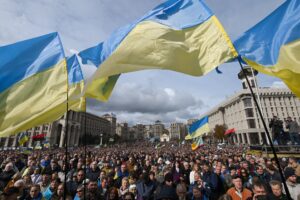What is it like to live in a city 3 400 meters above sea level, a city that was once the magical center of the Inca Empire? Cusco, or as the Inca would put it, the Belly Button of the World, is an Andean metropolis with about 450 000 inhabitants today. Its people and its architecture mirror the rich history of the enchanting city. It bears witness to the flowering of the Inca culture and the violent intrusion of the Spanish conquerors over 500 years ago. You will not experience so much Andean diversity anywhere else.
Life in the Andes, so close to the equator, starts early. The sun’s rays, much stronger in this altitude, bring the city to life before 6 am. Dogs bark, car alarms play their melodies, taxis honk, street vendors offer freshly squeezed orange juice, hot quinoa drinks and bread rolls with creamy avocado. Children in school uniform wait for one of the many buses, known as „combis“, and small corner shops as well as our language school open their cast-iron doors to the public.
Traffic is somewhat chaotic, but the many taxis, combis and private cars know how to maneuver around each other. Most landmarks and sights are located in the historical center, which has been declared World Cultural Heritage in 1985. Here you will also find many restaurants, shops, bars and of course our Spanish and Quechua language school ACUPARI. And everything within easy walking distance! After a leisurely stroll around the picturesque squares and small streets, the many cafés around the Plaza de Armas invite sit back and enjoy the beautiful panorama on the colonial balconies.
Not far from the main square is the San Pedro market, where you can buy freshly pressed juice and many, many other products from the valleys around Cusco. You’ll find Andean potatoes and maize in a plethora of shapes and colors. Do try the exotic fruits and local dishes, but make sure to quickly get past the meat vendors offering pig heads, offal and chicken feet. Much more pleasant are the flowers section and the stalls putting medicinal plants and ritual utensils on display. Although it is advisable to keep an eye on your possessions when in the market, the city center is a safe and peaceful place thanks to the ever-present tourism police. Oh, and how delighted the market women will be, when you talk to them in Spanish or even want to learn a bit of Quechua from them.
In the afternoon, you can visit the numerous churches and museums, or wander around the steep, cobblestone alleyways of the picturesque neighborhood of San Blas, which houses countless galleries, artisans, craft shops and restaurants. The Molino marketplace is also worth a visit. Formerly a black market, the formalized Molino now offers the latest trends from Europe and the USA for sale. Between kitchenware and clothing, you will find flat screen TVs, digital cameras and smartphones & accessories.
Cusco’s surrounding hills and valleys, strewn with eucalyptus trees, are ideal for hiking in beautiful nature. On the way, you can explore Inca ruins, spot grazing lamas and observe farmers go about their daily business in on the field or in small adobe house villages. The contrast of reality of life between city and countryside, as well as between the rich and poor is enormous. But it is precisely this juxtaposition of different South American realities that makes staying in Cusco and learning the language such a fascinating, true experience.
As the gateway to Machu Picchu, Cusco is well equipped to cater to the desires and needs of its international visitors. It has over 300 hotels and many clubs and bars to dance to Latin rhythms or listen to live bands. Ask your Tandem Partner to show you around the city’s vivid nightlife!
Cusco is the perfect place to get to know the South American mentality and lust for live: its many festivities and traditions will make sure you don’t get bored, but that you discover a little more every day about Peru and its way of life.
Source: Acupari











